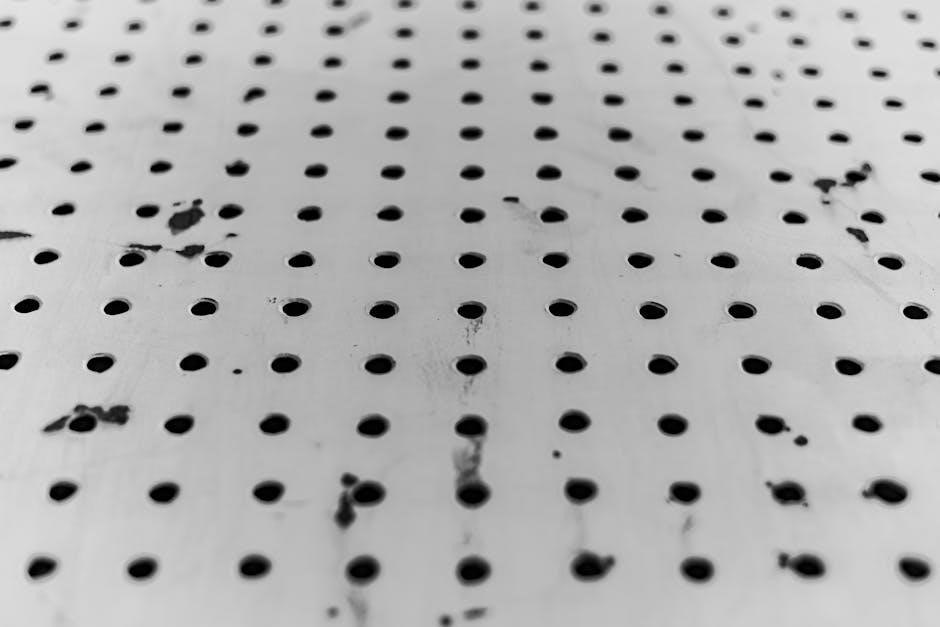Understanding graphic design pricing is essential for transparency and fair compensation. This guide explores industry standards, pricing models, and factors influencing costs, ensuring clarity for both designers and clients.
1.1 The Importance of Understanding Graphic Design Fees
Understanding graphic design fees is crucial for transparency, fairness, and successful project outcomes. Clear pricing structures eliminate ambiguity, ensuring clients and designers align on expectations, budgets, and deliverables. Graphic design fees reflect the designer’s expertise, time, and resources, while also helping clients understand the value they receive. By grasping these fees, both parties can set realistic objectives and avoid misunderstandings. Transparent pricing fosters trust and collaboration, enabling clients to appreciate the investment in their brand’s visual identity and marketing materials. This understanding also helps designers maintain professionalism and profitability, ensuring high-quality results that meet client needs. Clear fee structures are foundational for building lasting, successful partnerships in graphic design projects.
1.2 What This Guide Covers
This comprehensive guide provides an in-depth exploration of graphic design pricing, covering industry standards, pricing models, and factors influencing costs. It details common graphic design services, such as logo design, website graphics, and print materials, along with their associated fees. The guide also addresses additional costs, including revisions, software fees, and printing expenses. Furthermore, it offers insights into setting competitive rates, tailoring pricing strategies for different clients, and emerging trends like AI and automation. Whether you’re a designer or a client, this guide equips you with the knowledge to navigate graphic design pricing with clarity and confidence, ensuring fair and transparent transactions. It serves as a valuable resource for making informed decisions in the graphic design industry.

Factors Influencing Graphic Design Costs
Key factors influencing graphic design costs include provider type, project complexity, designer experience, and location, each shaping pricing structures and client expectations in unique ways.
2.1 Provider Type: Freelancers vs. Agencies
Freelancers typically charge lower rates due to reduced overhead, offering flexibility in pricing. Agencies, with their teams of experts, charge higher fees but provide comprehensive services, including project management and diverse skill sets. Freelancers are ideal for small, straightforward projects, while agencies are better suited for large-scale, complex tasks requiring multiple design disciplines. Both options offer unique benefits, making the choice depend on the project’s scope, budget, and client preferences. This section helps you decide which provider type aligns best with your needs and financial constraints, ensuring a balance between quality and affordability.
2.2 Project Complexity and Scope
Project complexity significantly influences graphic design costs, with intricate designs requiring more time and expertise. Complex projects, such as branding packages or custom graphics, often demand advanced techniques, increasing fees. Experienced designers charge higher rates due to their skill level and ability to deliver high-quality results. The scope of the project, including the number of revisions and specific requirements, also plays a role in pricing. This section explores how project complexity and designer expertise shape graphic design fees, helping clients understand the value behind the costs. Balancing these factors ensures fair pricing for both parties, ensuring the final product meets expectations while staying within budget.
2.3 Designer Experience and Expertise
A designer’s experience and expertise are critical factors in determining graphic design fees. Seasoned professionals typically charge higher rates due to their advanced skills, creative insights, and ability to deliver polished results efficiently. Their expertise ensures precision and innovation, often resulting in premium-quality designs that align with client objectives. Novice designers may offer lower rates as they build their portfolios. The level of expertise directly impacts the value clients receive, making it a cornerstone of fair pricing structures. This section delves into how experience influences costs, helping clients and designers understand the correlation between skill level and project outcomes, ensuring that fees reflect the quality and professionalism clients expect.
2.4 Location and Industry Standards
Location significantly impacts graphic design fees, as regional economic factors and industry standards vary. Designers in urban areas or high-cost-of-living regions often charge higher rates compared to those in smaller towns. Industry standards also play a role, with pricing differing across sectors. For instance, corporate clients may pay premium rates for specialized skills, while non-profits or small businesses may receive discounted fees. Local demand, competition, and cultural expectations further influence pricing. Understanding these geographical and industry-specific dynamics helps align pricing with market norms, ensuring fair and competitive rates for both designers and clients. This section highlights how location and industry standards shape graphic design pricing, providing insights for tailored fee structures.

Graphic Design Pricing Models
Graphic design pricing models include hourly rates, project-based fees, and package deals, offering flexibility and transparency for clients while ensuring proper fair compensation for designers.
3.1 Hourly Rate Pricing
Hourly rate pricing is a popular model where designers charge clients based on the time spent on a project. Rates typically range from $40 to $150 per hour, depending on experience and complexity. This method is ideal for ongoing or unpredictable projects as it offers flexibility. Clients pay only for the time invested, and designers receive fair compensation for their work. However, this model requires clear communication to avoid scope creep and ensures both parties agree on the expected hours. It’s popular for short-term or recurring design needs, offering transparency and adaptability. Hourly pricing balances client needs with designer expertise, ensuring quality outcomes while maintaining budget clarity.
3.2 Project-Based Pricing
Project-based pricing involves charging a fixed fee for a specific design task, offering clients upfront budget clarity. Services like logo design may cost between $50 and $300, while website graphics range from $100 to $500. Banners typically start at $80, with more complex designs increasing costs. This model is ideal for well-defined projects, ensuring clients know the exact cost and designers are incentivized to deliver quality work efficiently. Complex projects, such as branding packages, magazines, or custom graphics, can range from $250 to $2,000 or more. This approach aligns expectations and promotes accountability, making it a preferred choice for clients seeking predictable costs and clear deliverables.
3.3 Package Deals and Bundled Services
Package deals and bundled services offer clients discounted rates for multiple design tasks, providing cost efficiency and convenience. For instance, a logo package might include business cards and website graphics for $100, while branding packages offer comprehensive visual elements for $350. These deals attract long-term clients and streamline workflows for designers. Bundled services often include discounts for bulk orders, such as 20 social media posts at a reduced rate. This approach is ideal for startups and small businesses with multiple design needs, enhancing client satisfaction and fostering lasting relationships. By offering bundled services, designers can provide a one-stop solution, ensuring clients receive value while maintaining profitability and workflow efficiency.

Common Graphic Design Services and Their Costs
Graphic design services include logo creation, website graphics, and print materials, with costs varying by complexity. Logos range from $50 to $300, while website graphics start at $100.
4.1 Logo Design Pricing
Logo design pricing varies widely, ranging from $50 for basic designs by freelance designers to over $2,000 for complex logos by high-end agencies. Freelancers typically charge between $50 and $500, while agencies may quote higher due to additional services and expertise. The cost depends on factors like the designer’s experience, the number of revisions, and the project’s complexity. Basic logos may start at $100, with intricate designs requiring more time and creativity. Some designers offer package deals, including vector files and multiple concepts. Clarifying what’s included in the price is crucial for fair compensation and client satisfaction. This ensures transparency and value for both parties involved in the logo design process.
4.2 Website and Landing Page Design Costs
Website and landing page design costs vary significantly, ranging from $300 for simple landing pages to $15,000 or more for complex websites. Freelance designers typically charge between $1,000 and $5,000 for basic websites, while agencies may quote higher prices due to their expertise and additional services. Factors such as the number of pages, custom graphics, and responsive design influence pricing. Hourly rates for web design range from $75 to $150, with project-based pricing being common. Landing pages often cost between $300 and $2,000, depending on design complexity and features. These costs reflect the time, creativity, and technical skills required to deliver high-quality, user-friendly designs tailored to client needs;
4.3 Print Design Services (Business Cards, Brochures, Posters)
Print design services vary in cost based on design complexity and quantity. Business cards typically range from $50 to $100 for basic designs, while brochures can cost between $200 and $500. Posters and flyers often start at $100, with prices increasing for larger sizes or intricate details. Factors like custom graphics, fonts, and finishing options (e.g., matte or glossy) also influence pricing. Rush orders or additional revisions may incur extra fees, making it important to clarify requirements upfront. These costs reflect the designer’s time, creativity, and attention to detail, ensuring high-quality, professional print materials tailored to client needs and brand identity.
4.4 Social Media Graphics and Digital Assets
Social media graphics and digital assets are essential for brand engagement, with costs varying based on complexity and scope. Prices typically range from $40 to $250, depending on the design’s intricacy and the designer’s expertise. Basic social media posts or banners may start at $40, while detailed infographics or high-resolution assets can reach up to $250. Deliverables often include multiple file formats like PNG, JPG, and PDF to suit various platforms. Factors such as custom illustrations, animations, or rush orders can increase costs. Clear communication about requirements ensures accurate pricing and delivery of assets that align with the client’s brand and marketing goals. These services are crucial for maintaining a strong online presence and visual consistency.

Additional Costs to Consider
Beyond design fees, consider revisions, rush charges, software costs, and printing expenses. These extras ensure transparency and fairness, covering tools, licenses, and production needs effectively.
5.1 Revisions and Rush Fees

Revisions and rush fees are common in graphic design projects. Most designers include a set number of revisions in their initial quote, with additional changes billed at an hourly rate. Rush fees apply when clients request expedited delivery, often ranging from 10% to 50% of the total project cost. These fees vary depending on the designer’s experience and the project’s complexity. Clear communication about these charges in the pricing structure helps avoid misunderstandings and ensures smooth project execution. It’s important to outline these terms upfront to maintain transparency and fairness for both parties involved in the project. Properly managing revisions and rush fees ensures timely delivery and client satisfaction.
5.2 Software and Licensing Fees
Software and licensing fees are additional costs that may be passed on to clients. Designers often incur expenses for tools like Adobe Creative Suite, font licenses, and stock imagery. These costs can be included in hourly rates or charged as a flat fee. Licensing fees for premium assets, such as high-resolution images or custom fonts, vary based on usage rights. Transparency in outlining these fees ensures fairness for both parties. Designers should clearly communicate these expenses in their pricing structure to avoid misunderstandings and maintain trust. These fees are essential for maintaining professional standards and ensuring high-quality deliverables tailored to client needs.
5.3 Printing and Production Costs
Printing and production costs are additional expenses beyond design fees, covering materials and labor for physical outputs. These costs vary based on the type of print material, such as business cards, brochures, or posters. Factors like paper quality, ink, and finishing options (e.g., matte or glossy) influence pricing. For example, business cards may cost between $50 and $100, while brochures range from $200 to $500. Rush orders or special finishes can incur extra fees. Designers often outline these costs separately to ensure transparency, as they depend on client preferences and production requirements. Clearly communicating these expenses helps set realistic expectations and avoids budget surprises for clients.

Setting Your Graphic Design Rates
Align your rates with your skills, industry standards, and project complexity. Consider client needs and ensure transparency to establish fair and competitive pricing structures.

6.1 Evaluating Your Skills and Experience
Evaluating your skills and experience is crucial for setting accurate graphic design rates. Consider your expertise in tools like Adobe Creative Suite, your portfolio quality, and the complexity of projects you handle. Experienced designers typically charge higher rates due to their ability to deliver high-quality results efficiently. Reflect on your strengths, such as proficiency in logo design, web graphics, or print materials, and align them with industry standards. Assessing your experience helps determine your value, ensuring fair pricing that reflects your capabilities and the value you bring to clients.
6.2 Researching Industry Standards
Researching industry standards is vital to set competitive and fair graphic design rates. Review pricing guides, surveys, and benchmarks to understand average fees for services like logo design, web graphics, and print materials. Consider factors influencing costs, such as project complexity, location, and designer expertise. This research helps you identify market rates, ensuring your pricing aligns with industry expectations. By understanding what clients expect to pay, you can position yourself effectively in the market. Regularly updating your knowledge of industry standards allows you to adjust your rates accordingly, reflecting changes in demand, technology, or economic conditions. This ensures your pricing remains competitive and relevant.
6.3 Defining Your Pricing Model
Defining your pricing model is crucial for clarity and consistency in your graphic design business. Choose between hourly rates, project-based pricing, or package deals based on your workflow and client needs. Hourly rates suit ongoing projects, while project-based pricing offers fixed fees for specific tasks. Package deals bundle services, appealing to clients seeking comprehensive solutions. Consider your expertise, time, and resources when selecting a model. Clearly communicate the benefits of your chosen model to clients, ensuring transparency and value. This structured approach helps streamline projects, manage expectations, and maintain profitability. Aligning your pricing model with your business goals ensures long-term success and client satisfaction.
6.4 Creating a Detailed Rate Card
A detailed rate card is essential for transparency and professionalism in your graphic design business. Start by listing all services offered, such as logo design, website graphics, and social media graphics. Clearly define pricing structures, choosing between hourly rates, project-based pricing, or package deals. Include service descriptions to outline deliverables, like the number of concepts, revisions, and file formats. Specify additional costs for rush jobs or extra revisions to avoid surprises. Consider industry standards and adjust pricing based on project complexity and your expertise. Format the rate card with tables or lists for clarity, ensuring easy readability. Regularly update your rate card to reflect market changes and your growing experience. This organized approach helps clients understand your value and streamlines your business operations.

Tailoring Pricing Strategies for Clients
Tailoring pricing strategies involves understanding client needs and offering flexible models. This ensures transparency, value, and satisfaction, fostering long-term partnerships.
7.1 Pricing for Small Businesses
Pricing for small businesses focuses on affordability and flexibility, ensuring cost-efficiency without compromising quality. Many designers offer package deals or fixed rates for specific services, such as logo design starting at $50, business cards at $75, or website graphics at $100. These models allow small businesses to budget effectively while accessing professional designs. Some designers provide tiered packages, offering basic, standard, and premium options to cater to varying needs. Additionally, discounts for bulk orders or long-term contracts can further reduce costs. This approach helps small businesses achieve their branding goals while staying within financial constraints, making graphic design services accessible and valuable for growing companies.
7.2 Pricing for Large Corporations
Pricing for large corporations often involves higher fees due to the complexity and scale of projects. These clients typically require comprehensive services, including custom solutions, advanced branding, and ongoing support. Agencies are frequently chosen for their expertise and ability to handle large-scale tasks, charging premium rates for comprehensive packages. These packages may include multiple design elements, dedicated project management, and specialized services like UI/UX design. Pricing models for large corporations may also involve retainer agreements or customized deals tailored to their specific needs. The higher costs are justified by the level of expertise, the scope of work, and the long-term partnerships often required. This approach ensures that large corporations receive high-quality, tailored solutions that align with their brand and business goals.
7.3 Customizing Packages for Client Needs
Customizing packages for client needs ensures tailored solutions that meet specific requirements and budgets. This approach involves bundling services like logo design, website graphics, and social media assets into tiered packages. Basic packages might include essentials for startups, while premium options cater to established businesses needing advanced features. By offering flexible bundles, designers attract a wide range of clients, from small businesses to large corporations. Customization fosters satisfaction and long-term relationships, as clients appreciate the value aligned with their goals. This strategy also allows designers to highlight their expertise, ensuring each package delivers measurable results and clear ROI, making it a win-win for both parties.

Emerging Trends in Graphic Design Pricing
Emerging trends like AI, automation, and dynamic pricing are reshaping graphic design fees, enhancing cost efficiency and accessibility while offering flexible solutions for diverse client needs.
8.1 The Impact of AI and Automation
AI and automation are revolutionizing graphic design pricing by reducing manual effort and speeding up workflows. Tools powered by AI can generate initial drafts, suggest design elements, and optimize assets, lowering production costs. While these technologies increase efficiency, they also raise questions about the role of human creativity. Many designers are adapting by leveraging AI for repetitive tasks, allowing them to focus on high-value creative work. This shift is leading to new pricing models, such as subscription-based services for access to AI-generated design tools. As a result, clients may benefit from faster turnaround times and potentially lower costs, while designers can enhance their services with advanced technological capabilities.
8.2 Dynamic Pricing and Subscription Models
Dynamic pricing and subscription models are emerging trends in graphic design, offering flexibility and accessibility. Subscription-based services provide clients with ongoing access to design tools, templates, and support, often at a lower upfront cost. Platforms now offer tiered subscriptions catering to different client needs, from basic design tools for small businesses to advanced features for large corporations. Dynamic pricing adjusts costs based on demand, project complexity, or client budgets, ensuring fair and adaptable fees. These models allow designers to scale their services, attract a wider client base, and maintain recurring revenue streams. They also provide clients with predictable expenses and continuous value, fostering long-term partnerships and streamlined workflows in the graphic design industry.
8.3 The Role of Technology in Cost Efficiency
Technology plays a pivotal role in enhancing cost efficiency within graphic design. AI-powered tools automate repetitive tasks like color correction and layout adjustments, reducing time spent on manual work. Design software with cloud-based collaboration features streamlines workflows, minimizing errors and miscommunications. Additionally, template libraries and asset management systems allow designers to reuse elements, cutting down on creation time. These advancements enable designers to deliver high-quality work faster, reducing costs and increasing client satisfaction. By leveraging technology, designers can allocate more time to creative problem-solving, ensuring projects are both cost-effective and innovative. This shift not only benefits designers but also provides clients with more affordable and efficient solutions, driving the industry forward.
This guide provides a comprehensive overview of graphic design pricing, helping designers and clients understand fees, models, and factors influencing costs to ensure fair and transparent transactions.
9.1 Final Thoughts on Graphic Design Fees
Graphic design fees are a critical aspect of ensuring fair compensation for creativity and expertise. Transparency in pricing models, whether hourly, project-based, or bundled, fosters trust between designers and clients. By understanding industry standards, project complexity, and the value of experience, both parties can align expectations and budgets. Clear communication about revisions, rush fees, and additional costs is essential for smooth collaboration. As the industry evolves with AI and automation, pricing strategies must adapt to remain competitive while maintaining quality. Ultimately, fair and structured pricing ensures designers are valued for their work, and clients receive tailored solutions that meet their needs.
9.2 The Future of Graphic Design Pricing
The future of graphic design pricing is likely to be shaped by technological advancements and evolving client demands. AI and automation will continue to streamline workflows, potentially reducing costs for repetitive tasks while increasing demand for specialized skills. Dynamic pricing models and subscription-based services may become more prevalent, offering clients flexibility and predictable expenses. As the industry adapts, designers will need to balance technological efficiency with creative expertise to remain competitive. Additionally, transparency and value-based pricing will remain critical, ensuring clients understand the worth of custom design solutions. The integration of technology and human creativity will define the next era of graphic design pricing, fostering innovation and accessibility for both designers and clients.